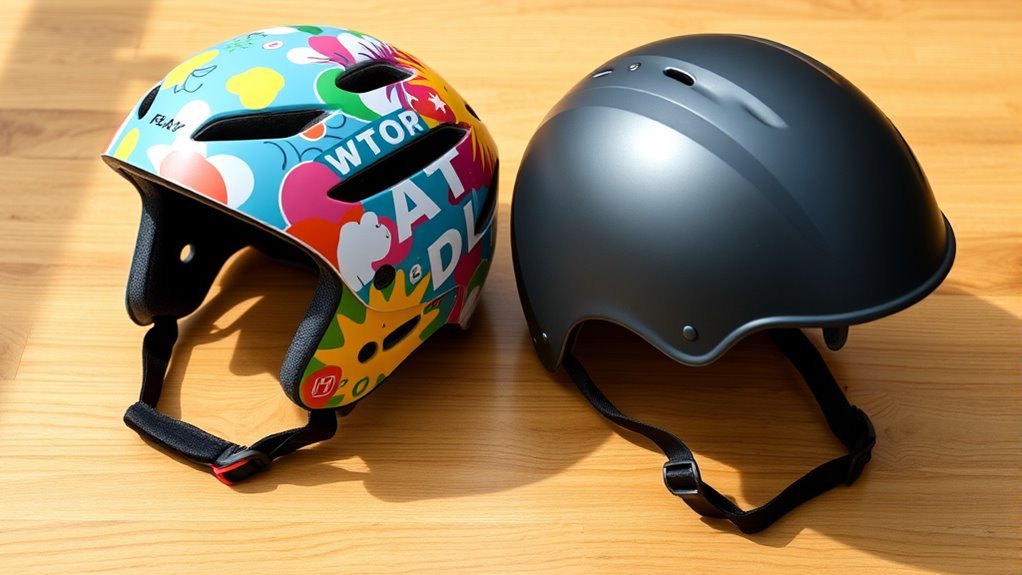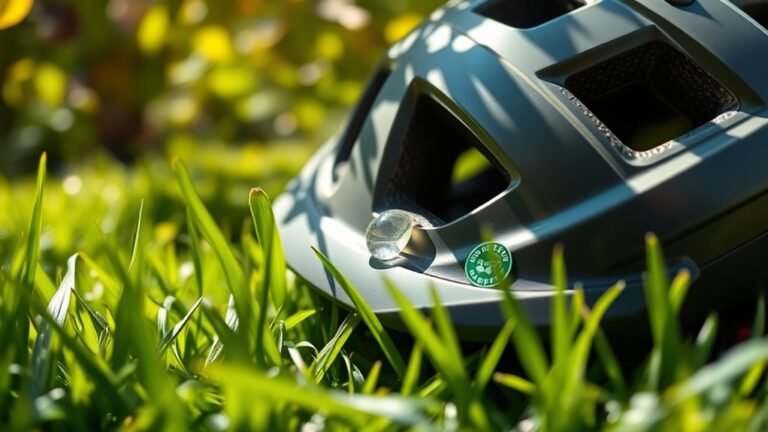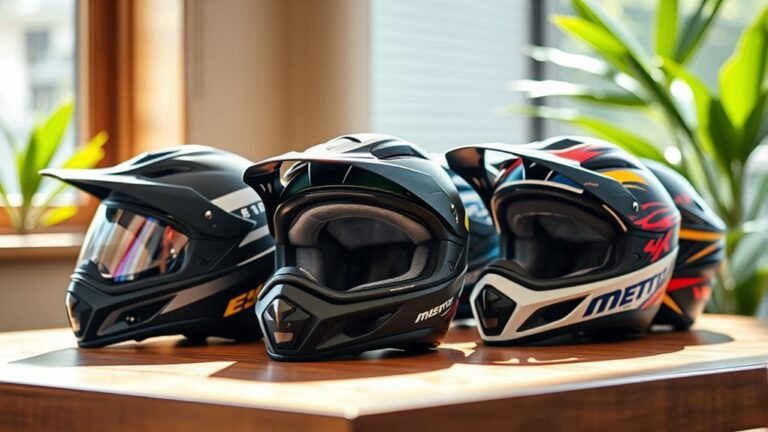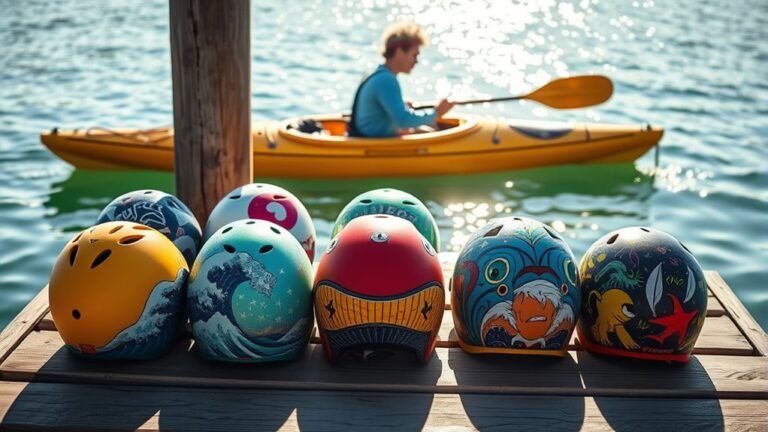Differences Between Recreational and Professional Water Helmets
Recreational and professional water helmets differ primarily in design, safety, and functionality. Recreational helmets focus on comfort and lightness for casual water activities, while professional ones are engineered for high-impact resistance and stability. You’ll find that professionals adhere to more rigorous safety standards, use advanced materials, and often feature enhanced fitting systems. Additionally, pricing reflects these differences, with recreational helmets being more budget-friendly. Explore further to understand how these distinctions impact your choice for different water activities.
Purpose of Water Helmets
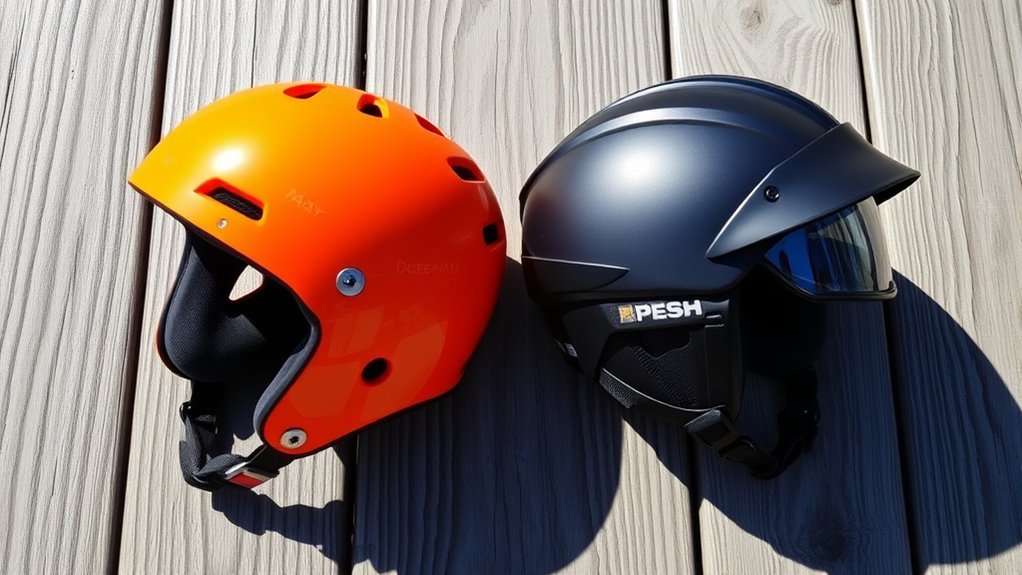
Water helmets serve a critical role in ensuring safety for both recreational and professional users. Their primary purpose is to protect your head from impacts, whether you’re maneuvering through rapids or engaging in water sports. Helmet features like adjustable straps, ventilation systems, and buoyancy aids enhance comfort and usability, making them essential gear for any water enthusiast. Advanced safety technology, such as impact-absorbing materials and reinforced shells, provides a higher level of protection against potential injuries. When choosing a helmet, consider how these features align with your activities. A well-fitted helmet doesn’t just safeguard your head; it enhances your freedom to explore water environments confidently. Understanding the purpose of water helmets enables you to prioritize safety while enjoying your aquatic adventures.
Design and Construction
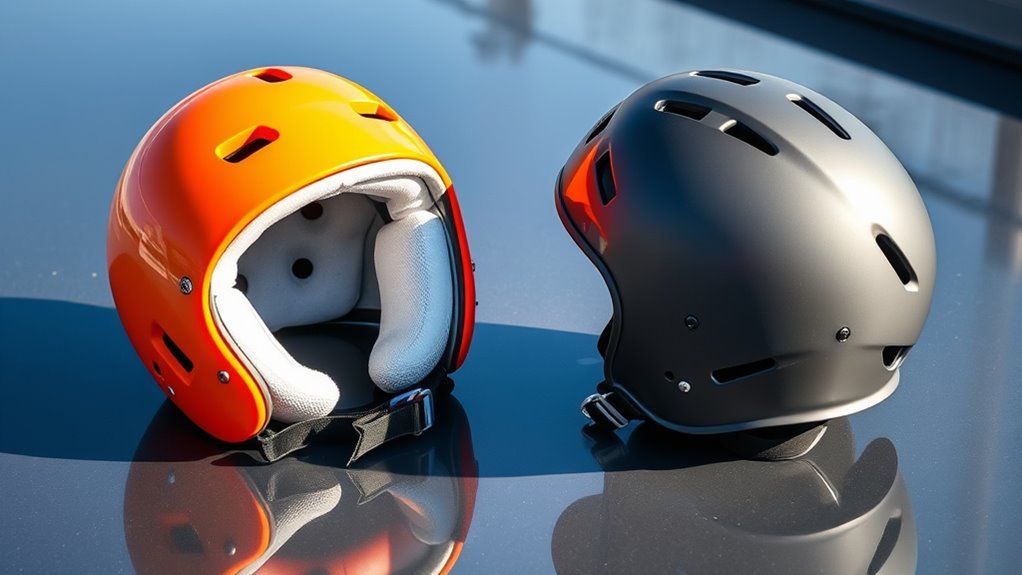
When comparing recreational and professional water helmets, the differences in material quality and impact resistance are critical. Recreational helmets often use lighter materials that prioritize comfort over durability, while professional models are constructed from high-grade composites designed to withstand significant impacts. Understanding these design aspects can help you choose the right helmet for your specific needs.
Material Quality Differences
While both recreational and professional water helmets serve the vital purpose of head protection, the materials used in their design and construction markedly differ. Recreational helmets typically utilize lower-cost plastics that prioritize comfort over longevity, which can impact material durability. In contrast, professional helmets are crafted from high-grade composites and advanced polymers, engineered through rigorous manufacturing processes to enhance strength and resilience. These materials not only withstand harsher environmental conditions but also offer a more precise fit for serious athletes. If you’re aiming for freedom in your water sports, understanding these differences is essential. Choosing the right helmet guarantees not just comfort but also maximum protection, so you can focus on your performance without compromising safety.
Impact Resistance Levels
Although both recreational and professional water helmets aim to protect your head, their impact resistance levels reveal significant differences in design and construction. Professional helmets undergo rigorous impact testing, ensuring they meet higher resistance ratings than their recreational counterparts. This means they can absorb and dissipate greater forces, essential during high-intensity activities like kayaking or white-water rafting. Recreational helmets, while suitable for casual use, often feature lower resistance ratings, which might not provide adequate protection in extreme conditions. When choosing a helmet, consider the specific activities you’ll engage in. Prioritizing impact resistance can mean the difference between a minor bump and a serious injury, allowing you the freedom to enjoy your water adventures with confidence.
Safety Standards and Certifications
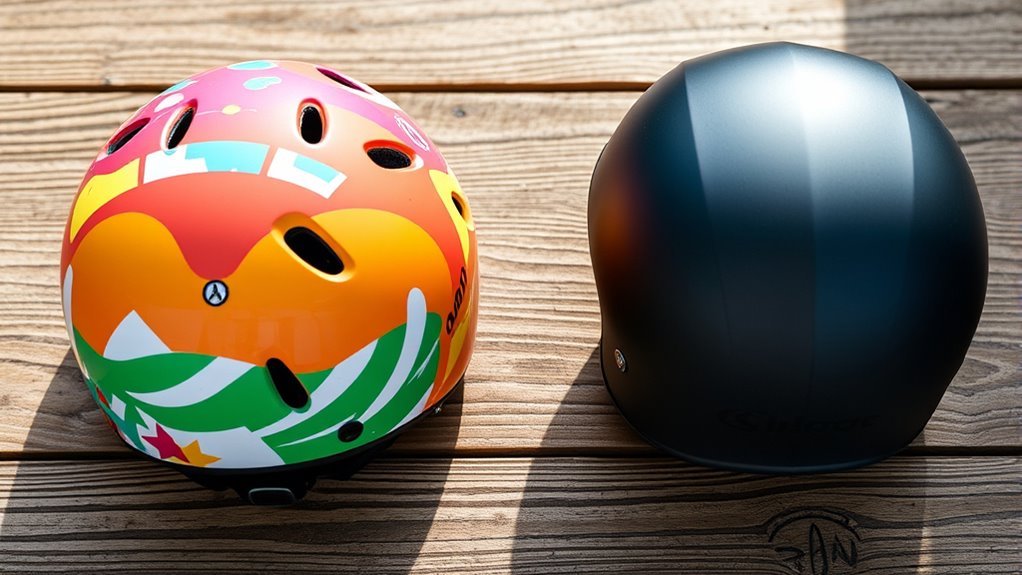
Safety standards and certifications play a crucial role in distinguishing recreational water helmets from their professional counterparts. Understanding the certification processes can help you make informed choices. Recreational helmets often meet basic safety testing requirements, guaranteeing they’re suitable for casual use. In contrast, professional helmets undergo rigorous safety testing that adheres to higher standards, reflecting their intended use in extreme conditions. These helmets typically carry certifications from recognized organizations, indicating they’ve been thoroughly evaluated for impact resistance and other safety features. When choosing a helmet, it’s important to look for these certifications; they not only provide peace of mind but also assure you’re equipped for the challenges you might face on the water. Prioritizing safety is key to enjoying your aquatic adventures.
Fit and Comfort
When selecting a water helmet, fit and comfort are essential for your performance and safety. Recreational and professional helmets often differ in size adjustment mechanisms, padding, and liner quality, which can greatly affect how the helmet feels during use. Additionally, weight distribution plays a key role in overall comfort, impacting how long you can wear the helmet without fatigue.
Size Adjustment Mechanisms
Finding the right fit in a water helmet is vital, as it can greatly impact both comfort and performance. Size adjustment technologies vary markedly between recreational and professional helmets. While recreational models often feature basic straps or toggles, professional helmets utilize advanced mechanisms like ratchet systems or sliding closures that guarantee a secure fit. These custom fit options allow you to fine-tune the helmet’s size, accommodating different head shapes and sizes. A well-fitted helmet not only enhances comfort but also offers better protection during water activities. When choosing a helmet, consider how these size adjustment mechanisms work, as they can make a considerable difference in your overall experience on the water. Your freedom to move and enjoy the sport depends on this vital aspect.
Padding and Liner Quality
While both recreational and professional water helmets prioritize fit and comfort, the quality of padding and liner materials markedly distinguishes them. Recreational helmets often feature basic foam padding types that provide adequate protection but may lack long-term comfort. In contrast, professional helmets utilize advanced padding types, such as memory foam or gel inserts, which conform better to your head’s shape, enhancing comfort during prolonged use.
Additionally, professional helmets incorporate higher-grade liner materials designed for moisture-wicking and quick-drying properties, reducing discomfort from sweat and water exposure. This attention to detail guarantees a snug fit without compromising on protection, allowing you the freedom to focus on your water activities. Ultimately, investing in a helmet with superior padding and liner quality can greatly elevate your experience.
Weight Distribution Differences
The quality of padding and liner materials directly influences how weight is distributed across the helmet. In recreational helmets, you may find basic padding that doesn’t prioritize weight balance, potentially leading to discomfort during prolonged use. In contrast, professional helmets utilize advanced distribution techniques, ensuring that weight is evenly spread. This design minimizes pressure points and enhances fit, allowing for longer, more enjoyable sessions on the water. You’ll notice that professional options often feature adjustable components to fine-tune the fit, which further aids in achieving ideal weight distribution. By choosing a helmet that aligns with your needs, you can enjoy the freedom of movement and enhanced comfort, whether you’re paddling leisurely or tackling challenging conditions.
Weight and Bulkiness
When considering water helmets, weight and bulkiness play essential roles in performance and comfort. You’ll want a helmet that’s light enough to allow freedom of movement but sturdy enough to provide protection. Recreational helmets typically have a bulkiness that can feel cumbersome, impacting your agility. In contrast, professional helmets often focus on a streamlined design, improving weight distribution to enhance comfort and reduce fatigue during long sessions. This bulkiness comparison highlights how professionals prioritize minimal weight and sleek profiles, enabling quicker reactions in demanding environments. Ultimately, the right balance between weight and bulkiness is vital for ensuring you feel unencumbered while you navigate water challenges, allowing you to focus on your performance without distractions.
Ventilation and Cooling Features
In addition to weight and bulkiness, ventilation and cooling features greatly influence comfort during water activities. The right helmet can enhance your experience considerably. Here are three key aspects to evaluate:
- Ventilation Systems: Effective designs allow airflow, reducing heat buildup and keeping you comfortable while paddling or surfing.
- Cooling Technology: Many professional helmets incorporate advanced materials that wick moisture, ensuring you stay dry and focused on your performance.
- Adjustable Features: Helmets with adjustable vents let you customize airflow based on conditions, giving you the freedom to adapt during varying weather.
With ideal ventilation and cooling, you can enjoy longer sessions in the water without discomfort, allowing you to concentrate on your skills and experience the thrill of your activity.
Price Range and Budget Considerations
How much you’re willing to spend on a water helmet can greatly impact your options and overall safety. When considering budget allocation, it’s essential to understand the price range of both recreational and professional helmets. Recreational models typically range from $30 to $100, focusing on affordability and basic protection. In contrast, professional helmets can cost anywhere from $100 to $300, prioritizing advanced safety features and durability. Conducting a price comparison helps you find the best fit for your needs, ensuring you’re not sacrificing safety for savings. Remember, investing a bit more in a high-quality helmet can provide peace of mind and enhanced protection, allowing you to enjoy your water activities with confidence.
Use Case Scenarios
While both recreational and professional water helmets serve the primary function of safety, their use case scenarios differ markedly based on the activity and environment.
- Recreational Activities: Helmets designed for casual kayaking or paddleboarding prioritize comfort, ventilation, and lightweight materials, allowing you to enjoy leisurely outings without feeling weighed down.
- Professional Competitions: In contrast, helmets used in competitive environments, like whitewater racing or freestyle events, focus on impact resistance and stability, ensuring maximum protection during high-speed maneuvers.
- Environmental Conditions: Recreational helmets may be optimized for calm waters, while professional helmets are engineered to withstand rougher conditions, adapting to the demands of rigorous competition.
Choosing the right helmet can greatly enhance your experience, whether you’re seeking freedom in recreational fun or aiming for victory in professional competitions.
Frequently Asked Questions
Can I Use a Professional Helmet for Recreational Activities?
Yes, you can use a professional helmet for recreational activities. These helmets often meet higher safety standards, providing enhanced protection. However, consider the activity suitability; some recreational sports may not require such advanced features. Using a professional helmet can offer peace of mind, but it might be bulkier or less comfortable than a recreational model. Ultimately, make sure it fits well and meets the needs of your chosen activity for best safety and freedom.
How Long Do Water Helmets Typically Last?
Water helmets typically last anywhere from three to five years, but this can depend on durability factors like usage frequency and the conditions they’re exposed to. If you’re using a helmet made from high-quality materials, you might find it protects you longer. However, wear and tear from sun exposure, impacts, and water can shorten its lifespan. Always inspect your helmet regularly; it could be the difference between safety and risk when you’re on the water.
Are Water Helmets Suitable for All Water Sports?
Water helmets aren’t suitable for all water sports. Different helmet types meet specific safety standards tailored for activities like kayaking or jet skiing, guaranteeing ideal protection. For instance, a recreational helmet may not provide the same impact resistance as a professional-grade helmet designed for extreme conditions. Always check the safety ratings and intended use of a helmet to verify it matches the demands of your chosen sport, allowing you to enjoy your freedom on the water safely.
Can I Customize My Water Helmet’s Design?
Yes, you can customize your water helmet’s design! Many brands offer various customization options, allowing you to choose colors, patterns, and even graphics that reflect your personality. Keeping up with design trends can enhance not just your helmet’s look but also its functionality. It’s crucial to verify that any modifications don’t compromise safety standards. So, have fun expressing your style while keeping your protection in mind!
How Do I Clean and Maintain My Water Helmet?
To keep your water helmet in top shape, start by rinsing it with fresh water after every use to remove salt or debris. For deeper cleaning, use mild soap and a soft cloth, avoiding harsh chemicals that could damage the helmet materials. Don’t forget to inspect the straps and padding regularly for wear. Storing it in a cool, dry place will also help prolong its life, ensuring you enjoy your adventures without worry.
